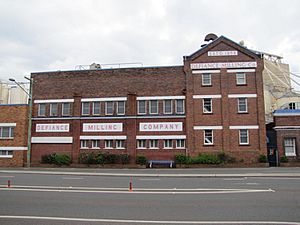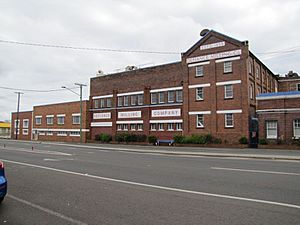Defiance Flour Mill, Toowoomba facts for kids
Quick facts for kids Defiance Flour Mill |
|
|---|---|

Defiance Flour Mill, 2012
|
|
| Location | 269-291 Ruthven Street, Toowoomba, Toowoomba Region, Queensland, Australia |
| Design period | 1870s - 1890s (late 19th century) |
| Built | 1911 |
| Architect | William Hodgen |
| Official name: Defiance Flour Mill | |
| Type | state heritage (built) |
| Designated | 26 February 2002 |
| Reference no. | 601306 |
| Significant period | 1911- 1920s (fabric) 1899-ongoing (historical, social) |
| Significant components | office/administration building, factory building, mill |
| Builders | WT Smith |
| Lua error in Module:Location_map at line 420: attempt to index field 'wikibase' (a nil value). | |
The Defiance Flour Mill is a historic building located at 269-291 Ruthven Street in Toowoomba, Queensland, Australia. It is a special mill that has been making flour for a very long time. The famous Toowoomba architect William Hodgen designed the main building. It was built in 1911 by WT Smith. This important site was added to the Queensland Heritage Register on 26 February 2002.
The Mill's Story
The Defiance Flour Mill sits in a busy part of Ruthven Street. It is right next to the Toowoomba Foundry and the Toowoomba Railway Station. The company started in 1898. It was founded by Patrick O'Brien and his wife Ellen. They partnered with George Crisp, an experienced miller. They first worked from a different spot. Then, in 1899, they moved to the current Ruthven Street location.
Long ago, in 1828, Europeans first explored the Darling Downs area. This was thanks to Allan Cunningham. He found a path through the Great Dividing Range. This path connected the Darling Downs to the Moreton Bay region. In 1840, Patrick Leslie was the first settler here. Soon, more people followed. By the 1860s, Toowoomba grew into a busy regional town. Many businesses started there.
Patrick and Ellen O'Brien came from Ireland. They got married in Toowoomba in 1884. They opened a grocery store. It was near another mill managed by George Crisp. Crisp had moved to Queensland in 1887. He was a very skilled miller.
By 1898, the O'Briens' store was doing well. They decided to open a new flour mill in Toowoomba. They became equal partners with Crisp. He became the manager and miller. The new Defiance Mill was very modern. It had the newest machines from England and America. It could make 16 tons of flour in just 24 hours!
The business grew quickly. In 1901, Defiance Milling Company bought another mill. This was Gisler's mill on Ruthven Street. Crisp managed both mills. In 1902, they bought another mill in Fortitude Valley, Brisbane.
In 1906, Patrick O'Brien passed away. Ellen, at 48, was left with ten children. She also had a growing milling business and the grocery shop. Ellen bravely continued to manage everything. She even had to find money to buy wheat. This was a big job for her.
In 1911, a new mill building was built on the Ruthven Street site. William Hodgen designed it. WT Smith built it. It was a four-story brick building. Sadly, it was badly damaged by fire less than two years later. But it was rebuilt. This rebuilt building is the main part of the mill you see today. New sheds for grain were built in 1914. They could hold 28,000 bags of grain.
George Crisp left the company after World War I. He sold his share to Ellen and retired. Then, Thomas Patrick, one of Ellen and Patrick's ten children, took over. He was also an experienced miller. He worked hard to make the best quality flour. He wanted the mill to be more competitive. Thomas often picked the wheat himself from farmers.
In 1923, the Brisbane Valley mill was sold. The Dalby Mill was bought. The business kept growing. It stayed a family business until 1955. Then, it became Defiance Milling Company Pty Ltd. Thomas Patrick was the main director. His sister Ellen and brother EF O'Brien were also directors.
The 1960s brought many changes to flour milling. A big English company, George Weston Foods, came to Australia. This meant more competition. It also led to new products like pre-mixed baking goods. In the late 1960s, Defiance built a mill in Rockhampton. This helped them protect their business in North Queensland. The first tall silos were also built in the 1960s. These silos are now a big part of the Ruthven Street site.
After Thomas Patrick O'Brien died in 1969, the company changed again. In 1976, it became a public company called Defiance Mills Ltd. The Ruthven Street site was fully updated during this time.
The company continued to expand. They built a mill in Melbourne. By 1987, Defiance owned mills in Toowoomba, Brisbane, and Rockhampton. They also partly owned the Dalby mill. They made more than half of all the flour in Queensland. They also made soya bean and rye products.
The main building, built in 1911, still works as a flour mill today. Most of the flour is now used to make other products. These include pre-mixed cake and bread mixes. The site also has a pre-mix factory, a retail factory, and an office.
What Does it Look Like?
The Defiance Flour Mill site is on Ruthven Street. It is next to the Toowoomba Foundry and the Toowoomba Railway Station. It is a very noticeable building in the area. You can see it clearly from both the east and west sides.
The main entrance is on Ruthven Street. The 1911 mill building is in the middle. It has two brick buildings on its north side. It also has three brick buildings on its south side.
The mill building is made of strong bricks. It has a gable roof, which means it has a triangular shape at the front. This front part faces Ruthven Street. The building has three stories. The words "Defiance Milling Co." and "Est. 1898" are painted on the front.
The sides of the building also have sections divided by brick columns. Each level has pairs of timber windows. The roof is made of corrugated iron. It has clear fibreglass panels to let in light. Five vents are along the top of the roof. Inside, the mill has been changed to fit new machines. It still works as a flour mill on three levels. It also has an original set of stairs at one end.
The buildings next to the mill are also made of brick. They have timber windows. The office building on the north side is a bit fancier. It has a simple decorated top edge and glazed bricks around the windows. The back of these buildings has metal sheeting and corrugated iron roofs. Many of the office areas inside have been changed.
To the south of the mill are the retail and pre-mix factories. These buildings have metal and timber frames. Their roofs are shaped like saw-teeth.
Most of the site is paved. There are large storage silos at both ends of the site. Newer storage buildings are at the back.
At the northern end, there is an old timber building. It used to be part of the nearby Toowoomba Foundry.
Why is it Special?
The Defiance Flour Mill is listed on the Queensland Heritage Register. This means it is very important! Here are some reasons why:
- It shows Queensland's history: The mill started in 1898. It shows how the flour industry grew in Queensland. It has been working for a very long time.
- It shows how mills work: The Ruthven Street site has grown and changed. This shows how flour milling technology has improved. It is a great example of an old industrial site that has kept working for over 90 years. The main 1911 building is a good example of an early 20th-century factory. It is also part of an industrial area near the Toowoomba Railway Station.
- It looks great: The mill is a landmark. It looks impressive from Ruthven Street and from the railway station side. The 1911 mill building is also a well-designed old factory building.
- It connects with people: The Defiance Flour Mill has been in Toowoomba for over 100 years. It has a strong connection with its past and present workers. It is also important to the local community.
- It is linked to a famous product: The mill is known for "Defiance flour." This is a famous Queensland product.
Awards
In 2015, Ellen O'Brien and Defiance Flour were honored. They were put into the Queensland Business Leaders Hall of Fame. The Defiance Flour company was family-owned for almost 100 years. It became a big business known across Australia and even overseas. This was because of new ideas, caring for customers, and loyal workers.


